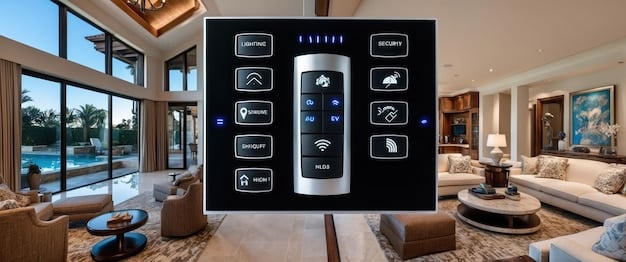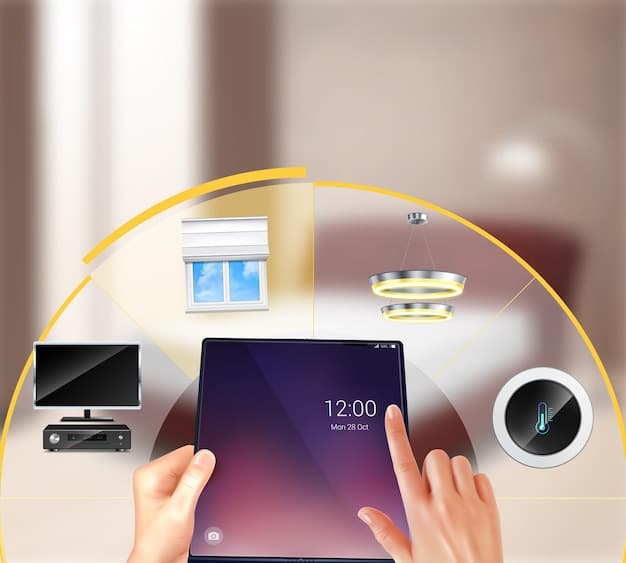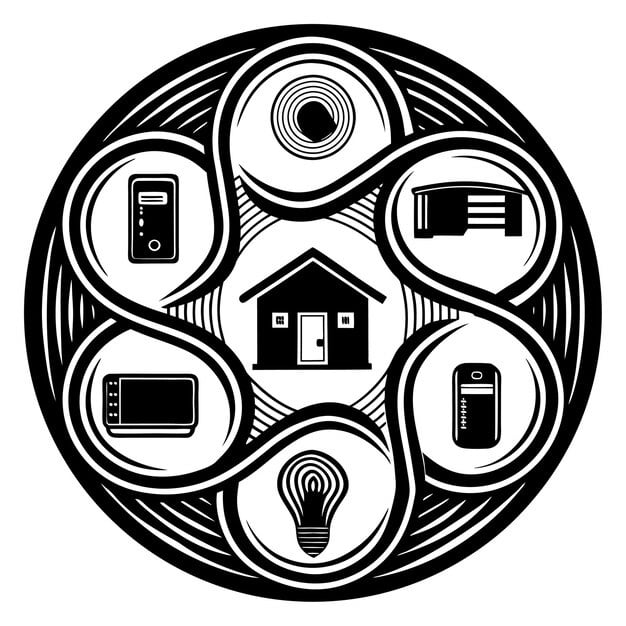Smart Home Hubs Compared: Your 2025 Guide to the Best Choice

Choosing the right smart home hub in 2025 involves comparing key features, compatibility, and user experience to create a seamless and efficient connected home ecosystem.
Welcome to your comprehensive guide comparing smart home hubs in 2025. Navigating the world of smart home technology can be overwhelming, but understanding the strengths and weaknesses of each hub will empower you to choose the perfect one for your needs.
Understanding Smart Home Hubs: The Core of Your Connected Life
Smart home hubs act as the central control point for all your connected devices. They allow you to automate tasks, monitor your home remotely, and create a more convenient and efficient living environment.
But what exactly makes a hub “smart,” and why is it essential for a truly connected home?
What Does a Smart Home Hub Do?
A smart home hub connects your various smart devices, such as lights, thermostats, locks, and security cameras, allowing them to communicate with each other and with you.
The hub provides a single interface for controlling all these devices, simplifying automation and providing a centralized view of your smart home.
Why Use a Dedicated Hub?
While some devices can connect directly to your Wi-Fi network, a dedicated hub offers several advantages, including:
- Improved Compatibility: Hubs often support multiple wireless protocols, ensuring compatibility with a wide range of devices.
- Enhanced Security: A central hub can provide a more secure connection point for your devices, reducing vulnerabilities.
- Simplified Automation: Hubs make it easier to create complex automation routines that involve multiple devices.
In conclusion, a smart home hub centralizes control, enhances compatibility, and bolsters security for your connected devices, making it a worthwhile investment.
Key Features to Consider When Choosing a Hub
Choosing the ideal smart home hub involves evaluating factors like compatibility, ease of use, and integration capabilities, balancing these with your specific needs.
Several key features differentiate the top contenders in the smart home hub market. Here’s what to consider:
Protocol Compatibility
One of the most important factors is protocol compatibility. Different devices use different wireless protocols, such as:
- Wi-Fi: The most common wireless protocol, used by many smart devices.
- Zigbee: A low-power wireless protocol often used for lighting and sensors.
- Z-Wave: Another low-power protocol popular for home automation.
- Bluetooth: Used for direct connections between devices and smartphones.
- Matter: A next-generation connectivity standard, promising seamless interoperability across different ecosystems.
Voice Assistant Integration
Seamless integration with voice assistants like Amazon Alexa, Google Assistant, and Apple Siri can significantly enhance your smart home experience. Consider:
- Voice Control: The ability to control your devices with voice commands.
- Routines and Scenes: Creating custom routines and scenes that can be activated with a single voice command.
- Integration with Other Services: Connecting your hub with other services, such as music streaming and weather updates.
User Interface and Ease of Use
A user-friendly interface is crucial for easy setup, configuration, and daily use. Key considerations include:
- Mobile App: A well-designed mobile app for controlling your devices remotely.
- Web Interface: A web-based interface for managing your hub from a computer.
- Intuitive Configuration: Simple and straightforward setup process.
Evaluate these key features—protocol compatibility, voice assistant integration, and a user-friendly interface—to ensure your smart home hub meets your needs and enhances your connected living experience.

Top Smart Home Hubs Compared for 2025
With numerous smart home hubs available, making an informed choice requires comparing features and performance.
Here’s a comparison of some of the top smart home hubs expected to be popular in 2025:
Amazon Echo (4th Gen)
The Amazon Echo (4th Gen) is a popular choice for its built-in Alexa voice assistant and support for Zigbee and Bluetooth. It can directly control many smart devices and integrates seamlessly with other Amazon services.
However, its Z-Wave support is limited, and it relies heavily on the Alexa ecosystem.
Google Nest Hub Max
The Google Nest Hub Max offers a large touchscreen display and built-in Google Assistant. It provides a visual interface for controlling your smart home and integrates well with other Google services.
It supports Wi-Fi and Bluetooth, but lacks Zigbee and Z-Wave support, limiting its compatibility with some devices.
Samsung SmartThings Hub
The Samsung SmartThings Hub supports a wide range of protocols, including Wi-Fi, Zigbee, Z-Wave, and Bluetooth. It offers a flexible platform for connecting and automating various smart devices.
It can be more complex to set up and configure than some other hubs, but its versatility makes it a popular choice for advanced users.
Apple HomePod mini
The Apple HomePod mini integrates seamlessly with the Apple HomeKit ecosystem and supports Siri voice control. It is a simple and elegant solution for controlling HomeKit-compatible devices.
Its compatibility is limited to HomeKit devices, making it less versatile than other hubs.
In summary, when choosing a smart home hub, consider factors like voice assistant preference, desired level of device compatibility, and ecosystem integration to make the best choice.
The Impact of Matter on Smart Home Hubs
Matter represents a pivotal development in smart home technology, addressing fragmentation and enhancing interoperability.
Matter is a new connectivity standard designed to provide seamless interoperability between different smart home devices and ecosystems.
Its adoption will significantly impact smart home hubs in several ways:
Simplified Device Setup
Matter simplifies the process of adding new devices to your smart home network. With Matter, devices from different manufacturers can be easily connected and controlled through a single hub.
This eliminates the need for multiple apps and accounts, streamlining the user experience.
Enhanced Interoperability
Matter ensures that devices from different ecosystems can work together seamlessly. For example, a light bulb from one manufacturer can be controlled by a hub from another manufacturer.
This enhanced interoperability provides more flexibility in building your smart home ecosystem.
Improved Security
Matter incorporates advanced security features to protect your smart home network from cyber threats. It uses strong encryption and authentication protocols to ensure that only authorized devices can connect to your network.
Future-Proofing Your Smart Home
Choosing a Matter-compatible hub is a good way to future-proof your smart home. As more devices adopt the Matter standard, your hub will be able to connect and control them seamlessly.
This standard promotes interoperability, simplifies setup, enhances security, and future-proofs your smart home investment.

Setting Up and Troubleshooting Your Smart Home Hub
Setting up a smart home hub requires a systematic approach to ensure smooth integration and prevent common issues.
Setting up a smart home hub can be straightforward, but it’s important to follow the correct steps to ensure a smooth installation. Here’s a general guide:
Initial Setup
Start by connecting your hub to power and your home network. Most hubs require a Wi-Fi connection, while some also support Ethernet.
Download the hub’s mobile app and follow the on-screen instructions to create an account and configure your hub.
Connecting Devices
Once your hub is set up, you can start adding your smart devices. The process for connecting devices varies depending on the hub and the device.
Typically, you’ll need to put the device into pairing mode and follow the instructions in the hub’s app.
Troubleshooting Common Issues
Despite careful setup, you may encounter some common issues. Here are a few troubleshooting tips:
- Connectivity Problems: Ensure your hub and devices are within range of your Wi-Fi network. Check your internet connection and restart your hub and devices.
- Device Compatibility: Verify that your devices are compatible with your hub. Check the hub’s documentation or website for a list of compatible devices.
- Voice Control Issues: Ensure your voice assistant is properly configured and connected to your hub. Check your voice commands and try rephrasing them.
Proper setup, combined with effective troubleshooting, ensures your smart home hub operates smoothly, enhancing your connected living experience.
The Future of Smart Home Hubs: Trends to Watch
Looking ahead, smart home hubs are poised for innovation, with integration, AI, and enhanced security shaping their future.
The smart home market is constantly evolving, and smart home hubs are expected to continue to play a central role in the connected home of the future. Here are some trends to watch:
Increased Integration
Smart home hubs will continue to integrate with more devices and services, providing a more seamless and comprehensive smart home experience. This includes integration with health and wellness devices, energy management systems, and entertainment platforms.
Artificial Intelligence (AI)
AI will play an increasingly important role in smart home hubs. AI-powered hubs will be able to learn your habits and preferences, automatically adjusting settings and automating tasks without requiring manual input.
Enhanced Security
As smart homes become more integrated, security will become an even greater concern. Future smart home hubs will incorporate advanced security features, such as biometric authentication and intrusion detection, to protect your home and data from cyber threats.
Edge Computing
Edge computing will enable smart home hubs to process data locally, reducing latency and improving performance. This will allow for more responsive and reliable smart home automation, even when the internet connection is down.
As technology evolves, these trends will continue to enhance the capabilities of smart home hubs, offering users more seamless, secure, and intelligent connected living experiences.
| Key Aspect | Brief Description |
|---|---|
| 💡 Compatibility | Ensuring the hub supports Wi-Fi, Zigbee, Z-Wave, Bluetooth, and Matter to connect various devices. |
| 🗣️ Voice Control | Seamless integration with voice assistants like Amazon Alexa, Google Assistant, and Apple Siri. |
| 🔒 Security | Advanced security features such as encryption, authentication, and intrusion detection to protect your data. |
| ⚙️ Ease of Use | Intuitive mobile app and web interface for easy setup, configuration, and control of your smart home devices. |
Frequently Asked Questions
▼
A smart home hub is a central device that connects and controls various smart devices in your home, allowing them to communicate with each other and you. It simplifies automation and enhances security.
▼
Key features include protocol compatibility (Wi-Fi, Zigbee, Z-Wave, Bluetooth, Matter), voice assistant integration (Alexa, Google Assistant, Siri), and user interface and ease of use.
▼
Matter simplifies device setup, enhances interoperability between different ecosystems, improves security, and helps future-proof your smart home, ensuring compatibility with new devices.
▼
Common issues include connectivity problems, device compatibility issues, and voice control failures. Troubleshooting steps include checking Wi-Fi, verifying compatibility, and reconfiguring voice settings.
▼
Future trends include increased integration with various devices and services, the use of AI for automation, enhanced security features, and edge computing for improved performance and reduced latency.
Conclusion
Choosing the right smart home hub compared: choosing the right hub for your needs in 2025 involves considering your specific needs, compatibility requirements, and desired level of integration. By understanding the key features and future trends, you can make an informed decision and create a truly connected and intelligent home.





